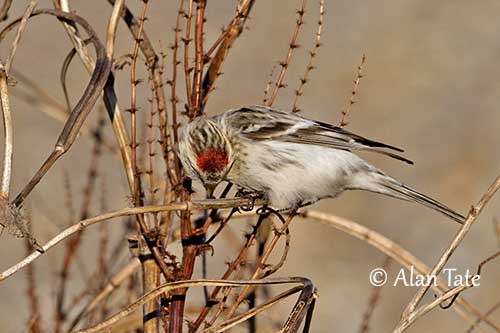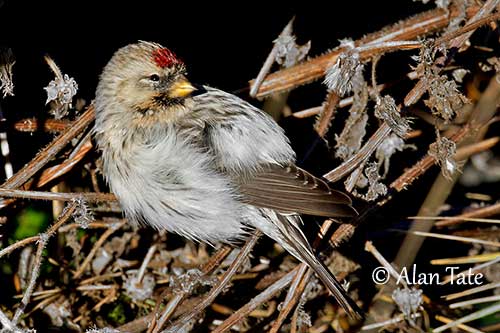
Fr: Sizerin blanchâtre
Ang: Arctic Redpoll – Hoary Redpoll
All: Polarbirkenzeisig
Esp: Pardillo Ártico
Ita: Organetto artico
Nd: Witstuitbarmsijs
Sd: snösiska
Photographers:
Tom Grey
Tom Grey's Bird Pictures & Tom Grey's Bird Pictures 2
Otto Plantema
Trips around the world
William Price
PBase-tereksandpiper & Flickr William Price
Alan & Ann Tate
AA Bird Photography
Ingo Waschkies
Bird Photography
Text by Nicole Bouglouan
Sources:
HANDBOOK OF THE BIRDS OF THE WORLD Vol 15 by Josep del Hoyo-Andrew Elliot-David Christie - Lynx Edicions – ISBN: 9788496553682
THE HANDBOOK OF BIRD IDENTIFICATION FOR EUROPE AND THE WESTERN PALEARCTIC by Mark Beaman, Steve Madge - C. Helm - ISBN: 0713639601
FIELD GUIDE TO THE BIRDS OF NORTH AMERICA - National Geographic Society -ISBN: 0792274512
All About Birds (Cornell Lab of Ornithology)
Bird Web (Seattle Audubon Society)
What Bird-The ultimate Bird Guide (Mitchell Waite)
Wikipedia, the free encyclopaedia
Partners in Flight - A Coalition of Diverse Partners
ARCTIC REDPOLL IDENTIFICATION REVISITED by Lee G R Evans ©
Polar Conservation Organisation - Arctic Redpoll Facts
Arctic Redpoll or Hoary Redpoll
Acanthis hornemanni
Passeriformes Order – Fringillidae Family
INTRODUCTION:
The Arctic Redpoll or Hoary Redpoll closely resembles to Common Redpoll, but it is paler overall and shows some differences in plumage pattern. It breeds in the northernmost parts of N America and Eurasia, and moves south after the breeding season.
Two subspecies are recognized, the Greenland or Hornemann’s Arctic Redpoll of Greenland and adjacent parts of Canada, and Coues’s Arctic Redpoll of N North America and N Eurasia. The race “hornemanni” is more widespread than “exilipes”.
The Arctic Redpoll or Hoary Redpoll is not globally threatened and both populations are currently relatively stable.
The redpolls have elongated, soft-tipped body feathers that allow the birds to trap the air efficiently against the body, in order to protect them from the cold. They also have feathered body areas that are bare in most other bird species. The birds may remove these feathers with the bill if the temperatures get too high. They will grow back in a few days.

DESCRIPTION OF THE BIRD:
Biometrics:
Length: 11,5-14 cm
Weight: Nominate race: 17-20 g – Race exilipes: 10-16 gr
The Arctic Redpoll or Hoary Redpoll is usually greyer (less brown) than the Common Redpoll, and differs from the latter by slightly larger size and shorter bill, unstreaked white rump, also unstreaked undertail-coverts, or with a single fine streak, and finer and less extensive streaking on sides. The male is slightly washed pale pink on breast, whereas the Common Redpoll has uniform deep pink breast coloration.
This medium-sized finch is grey to whitish with streaked upperparts, and two white wingbars formed by the whitish tips of the wing-coverts. The upperwing appears blackish, with pale edges to the dark flight-feathers. The blackish tail is slightly forked. Lower back and rump are white or washed pinkish, and the uppertail-coverts are whitish with dark centres.
The underparts are mostly white with pink tinge on breast centre. The flanks are narrowly streaked greyish. The undertail-coverts are white, although the longest feathers show thin, dark grey, central shaft streak.
On the head, crown and nape are whitish-grey and finely streaked blackish. The lower part of the forehead is greyish-white, whereas upper forehead and forecrown are deep red (sometimes tinged orange or yellow). The supercilium is white to whitish-grey, and extends over the whitish, finely streaked grey ear-coverts. Neck sides are white to pale grey. Lores and chin are black.
The short, conical bill is bright orange to deep yellow, with dark tip and culmen. The eyes are blackish-brown, with black spot behind the eye. Legs and feet are blackish.
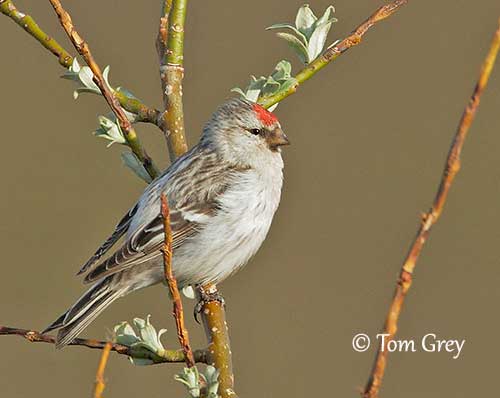
The Arctic Redpoll or Hoary Redpoll in non-breeding plumage has looser, fluffed-out plumage with pinkish-red forecrown. The upperparts are broadly streaked brown with white-edged feathers. The scapulars are darker but the rump is whiter, with dark tips to upper rump feathers in late winter/early spring, becoming washed pinkish in worn plumage. Outer rectrices have white edges.
On the underparts, the breast is whiter like rest of underparts, but it becomes pink as wear progresses. The undertail-coverts are white, and the central dark shaft streak may be absent or not.
The female resembles male but she lacks the pink on breast and rump. Her face is slightly greyer than that of male and the forecrown shows a smaller red area. Sides of mantle and scapulars are more buffy-brown. The underparts are whitish with grey-brown streaks on breast sides and flanks. The undertail-coverts may have one or more shaft streaks.

The juvenile resembles female but it has pale grey or washed buffish head and upperparts, broadly streaked dark except on the rump.
The 1st winter resembles respective adults, but it has buffish wash on mantle in fresh autumn/winter plumage. The bill is dull yellow with darker tip.
SUBSPECIES AND RANGE:
The Arctic Redpoll or Hoary Redpoll has two subspecies.
A.h. exilipes breeds in extreme N Eurasia from N Norway, N Sweden and N Russia, E to Bering Sea and Anadyrland, and in N North America from W and N Alaska, E in Canada to N Yukon, N Nunavut and N Manitoba.
It winters in N Europe and S in Asia to N China and Sakhalin Island, but also throughout Alaska and Canada, and S Greenland.
This race is smaller and duller than nominate, and has shorter bill. It is less extensively white, with buffy-brown head, greyish-white nape to back, white rump and grayish streaking or spotting on upper edge in worn plumage. In fresh plumage, central and lower rump are tinged pink. The underparts are washed pink and flanks are finely streaked. The undertail-coverts are often unstreaked or with a single dark central streak on the longest feathers.

A.h. hornemanni (described above) breeds on several islands in N Canada, and W and E Greenland. It winters S to C and NE Canada (to N Quebec and Labrador) and NE USA.
HABITAT:
The Arctic Redpoll or Hoary Redpoll breeds above the arctic tree line in sheltered areas, in arctic tundra scrub with dwarf willows and birches, heaths, spruces and alders. Outside the breeding season, it occurs at edges and clearing of open woodlands, fields and weedy areas, and along timber line in N Siberia.
The nominate race winters in valleys and slopes in the drier interior of Greenland. It is visible from sea-level to 450 metres in Canada and Greenland, and up to 1300 metres of elevation in Kamchatka.
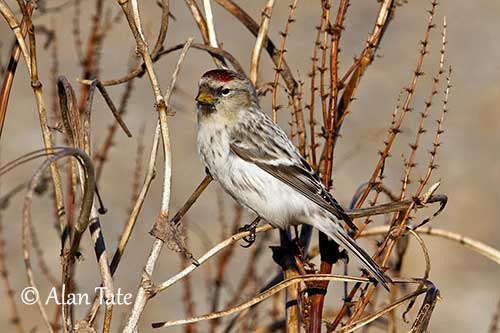
CALLS AND SONGS: SOUNDS BY XENO-CANTO
The Arctic Redpoll or Hoary Redpoll’s calls and songs are fairly similar to Common Redpoll. However, the twittering call is slightly lower “che-che-che” rapidly repeated several times. The birds in flocks give thin, rising “tsooeee”. The alarm call is a sharp “pii”.
The ringing whistle of a perched bird is hoarser, and falls slightly at the end, rather than rising “lil-lil-lil-r-r-r-r-r-ee”. It is also given in flight. Whirring sounds can be heard too.
BEHAVIOUR IN THE WILD:
The Arctic Redpoll or Hoary Redpoll feeds primarily on seeds of several plant species including alders and birches in winter. It also takes buds and shoots from various plants and trees.
In Alaska, it feeds on some invertebrates during the breeding season, usually insects and larvae of Hemiptera, Diptera, Lepidoptera, Coleoptera and also spiders.
During winter, it forages mainly on the ground and in the vegetation, hanging upside-down to reach the food items. It uses its feet to hold the food.
This species can store food in the extended sections of the esophagus. This food is very useful during the long winter nights. It feeds in pairs or in small groups, but outside breeding season, large mixed-flocks (up to 100 birds) with Common Redpoll are common where their ranges overlap.
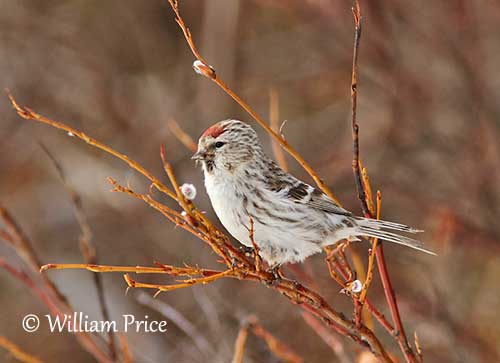
The Arctic Redpoll or Hoary Redpoll does not defend a territory, but only a small area around the nest. It also performs courtship displays while uttering its rapid twittering call. As the female is on the ground, it approaches in flight and hovers above her in narrow arc, prior to copulation. It also performs courtship feeding. They are monogamous.
Once the pair is formed, both mates stay together, and the male performs “mate-guarding” until the egg-laying is done. During the incubation, it feeds the female at nest.
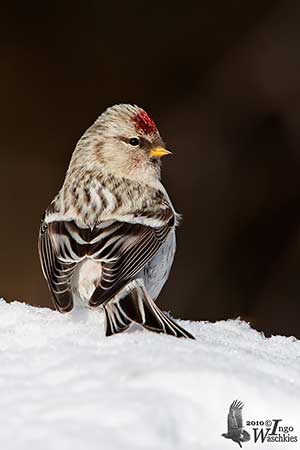
The Arctic Redpoll or Hoary Redpoll is sedentary to migratory. The subspecies A.h. exilipes moves often with the Common Redpoll.
Large numbers of birds of nominate race remain all year round in C and S areas of their breeding range. The annual variation of the numbers is due to food availability and weather conditions. Other birds migrate short distances to S of the breeding range between mid-August and early October. They return N to their breeding areas in late winter/early spring.
The race “exilipes” leaves N USA and S Canada from mid-March/early April, with some later movements into early May.
The Arctic Redpoll or Hoary Redpoll has swift bouncing flight like numerous Fringillidae species, with rapid wingbeats interspersed with glides.
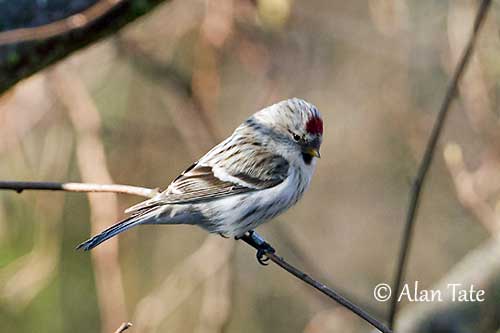
REPRODUCTION OF THIS SPECIES:
The breeding season takes place between May and July.
The Arctic Redpoll or Hoary Redpoll nests solitary or in loose colonies. It defends a small area around the nest-site. This species produces a single brood, sometimes two in N Canada and Siberia.
The nest is built by the female with twigs, grass and rootlets. The cup is lined with softer grass, feathers and animal hair. It is placed in low bush or on the ground, protected by rocks or vegetation, or in rocky crevice, or in low tree between 50 cm and 2 metres above the ground. It is often placed near or even above water.
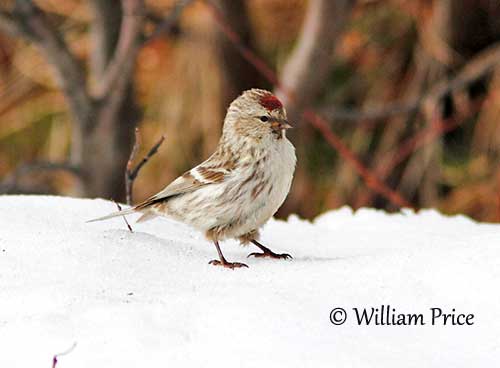
The female lays 3-6 (4-5) pale green/blue eggs with dark spots and speckles. She incubates alone during 11-13 days, while the male feeds her at nest. The chicks are fed by both parents, mainly with soft-bodied arthropods and larvae. They fledge 12-15 days after hatching. Many nests are destroyed in N Siberia by rise of water levels.
PROTECTION / THREATS / STATUS:
The Arctic Redpoll or Hoary Redpoll is common to locally common throughout the range, but the numbers of breeding birds vary annually from absent to abundant.
The European population is estimated at 7,000/22,000 pairs, and the Russian population at 100,000/1,000,000 pairs.
Information about N American population is not available, because of remote breeding and wintering areas. However, this population is estimated at several millions by Partners in Flight.
The breeding population of subspecies “exilipes” appears to be stable due to constant supply of willow seeds and buds.
The Arctic Redpoll or Hoary Redpoll is currently not globally threatened.
